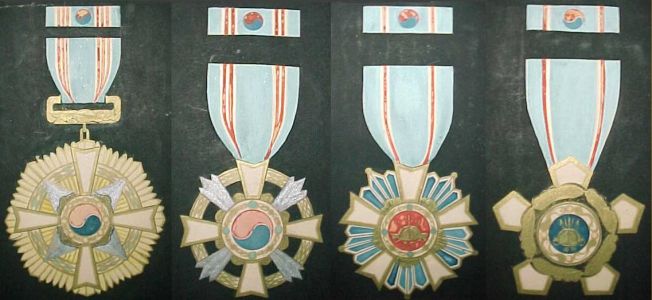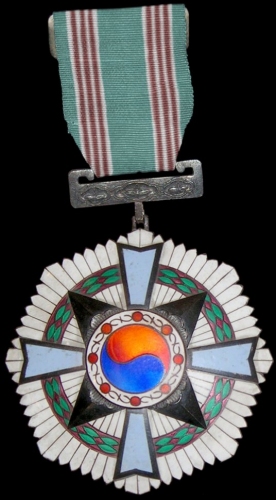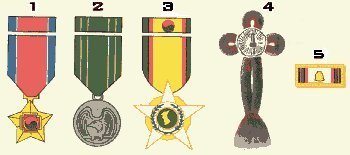There are actually dozens of medals that I am interested in and a ton of questions that need to be answered. Below is just a short list of some of them. If you can be of any assistance, please contact me.
Order of Military Merit

The medals, pictured to the left, are the original drawings for the October 1950 Series of the Order of Military Merit. This design might be as far as the Korean government went, and that these medals were never produced. However, ribbon bars for this series are known to exist. I now have the 1st, 2nd and 3rd Class ribbon bars for this series and I have an excellent picture of the 4th class ribbon bar. It still does not answer the underlying question of whether the medals were issued. Nancy Stout, the owner of the 4th Class ribbon bar, has clear documentation that her father received the ribbon bar in lieu of the medal. He later received the medal from the subsequent 1951 design of the Order of Military Merit. While the legislation is relatively clear, the lack of any examples of the medals from the October or December legislation creates a dilemma. We cannot state categorically what transpired during this period. Especially when you consider that the Korean War was in full swing. I need to find at least one example of any class from the October 1950 Series to at least confirm that the series was manufactured. I also need to find at least one example from any class of the December 1950 Series, preferably with a Gold or Silver Star attached. Please, if you have one of these medals or know where one is at, please send me the information so that I can obtain pictures.1
The picture of the medal to your right was found on a Chinese website. There was no explanation concerning the medal. I tried to make contact with the website, but it has since disappeared and, no longer exists. With only an obverse picture, I cannot vouch for its authenticity.

Ki Jang Medals from the Korean War Period

The first medal is the Korean Wound Medal. I am looking for an example with a serial number. The second medal is the Guerilla Warfare Service Medal. I have an example of the modern production pieces, and I have been able to purchase two complete original medals and two original planchets without ribbons. The two medals with ribbons are almost identical to each other, but the two original planchets without ribbons differ from each other and from the original planchets with ribbons. This is probably due to wartime exigencies. If anyone has an original one, with or without ribbon, in their collection or a relatively good picture of an original, please email me, I would love to get some pictures for comparison. The third medal is the original Korean War Participation Medal. I have been able to purchase two of these medals. One of them has English text on the reverse, and there is nothing in the original legislation which authorizes this text, so it may be a reproduction. The other example has a plain reverse, but the map of Korea in the center of the obverse is backwards, which I seriously doubt that the Koreans would miss this sort of mistake. The map being backwards would also indicate that this example was probably produced outside of Korea, most likely Japan, but this is purely speculation. At this point, I have no idea if either of them is original or reproduction. I would appreciate hearing from anyone who has one. I am hoping to get some idea of how many were issued and to see if I can gain some insight into the who, what, when and where of their manufacture and issuance. The fourth medal is the Next of Kin Medal. I have been fortunate enough to purchase two of them and to examine another one. Because these were produced during the war, I am interested in seeing if there were any variations in their manufacture, similar to what I have seen in the Guerilla Warfare Service Medal. The fifth item is the Presidential Citation for Individuals. Andrew Scoulas has sent me a great picture of the one in his collection, but I have not had an opportunity to examine an original.
Problems with Prewar Police Awards
In 1946, the U.S. Military Government in Korea (USAMGIK) reported, “The Department of Police has adopted a system of awards for bravery consisting of four citations”. These are: The highest award is for: “Gallantry and Intrepidity at imminent personal hazard of life and with knowledge of the risk assumed.” It is a cloth decoration containing three white stars on a yellow background, to be worn on the lower right sleeve. The other awards are for: “Personal combat with an armed opponent in the line of police duty, with an act of extraordinary heroism at imminent risk of life”, “Personal risk of life in intelligent performance of police duties”, and “Acts of personal bravery or highly intelligent police work”. There is no mention of what the other three awards looked like, but it is assumed that they were probably also cloth decorations possibly containing a lesser number of stars (or no star for the 4th citation), on a yellow background. This is all the information that I have on these awards, and because these awards were with the National Police Administration and not with the central government, there is no information readily available. I have not been able to get any cooperation from the Korean National Police.
Additional Research Projects (A.K.A. Prewar Headaches)
In 1946, the United States Military Government in Korea (USAMGIK) reported that: “The Korean Constabulary and Coast Guard personnel who served with national defense units at any time between 16 January 1946 and a date yet to be announced will be awarded the Korean National Defense Organization Service Ribbon.” No information is given on the design of the ribbon. There are other sources which mention an Honor Medal of the National Defense Constabulary Forces. These might be one and the same award. Additional research is required.
There are other Constabulary and Coast Guard Awards. In the same publication mentioned above, USAMGIK reports: “Other newly established decorations and awards for which national defense personnel may be eligible are”: The Constabulary Decoration for Meritorious Service and the Coast Guard Decoration for Meritorious Service. The Constabulary Decoration for Gallantry and the Coast Guard Decoration for Gallantry. The National Defense Service Injury Award. The National Defense Exemplary Service Medal for Constabulary and Coast Guard Enlisted Personnel. Unfortunately, no information is given as to the appearance of the awards or to the award criteria. Additional research is required.
On Apr. 21, 1950, Syngman Rhee, the President of the Republic of Korea, wrote a letter to the Charge d’Affaires, Mr. Everett F. Drumright at the American Embassy in Seoul. In the letter he states: “The Korean government is planning, in connection with the celebrations on Liberation Day, August 15, this year, to award a Liberation Medal and Ribbon to all members of the United States Armed Forces who served in Korea from the close of the war in 1945 until the establishment of the Government of the Republic of Korea on Aug. 15, 1948.” This offer was turned down by the U.S. government. However, with the letter having been dated for late April and the awarding scheduled less than 4 months later, it is reasonable to assume that prototype medals were made or at the very least designed. To date, no information on the design of this “Liberation Medal” has surfaced. Additional research is required.
In a follow-up letter to the U.S. State Department concerning Syngman Rhee’s offer of a “Liberation Medal”, Mr. Drumright wrote: “The Embassy further understands that at a later date, the President wishes to give an award to the Korean Military Assistance Group (KMAG) personnel, but that he wishes first to give proper recognition to the U.S. Armed Forces in Korea (USAFIK).” It is possible that, buried somewhere in the Korean archives, there may be a sketch of this proposed medal. Additional research is required.
On these last two Research Projects, I asked a Korean to go to the Presidential National Archives and see if the Archives would assist me in my research or if they could recommend someone to do the research. They stated that they could not help. To date, I have not been able to find someone in Korea to do the legwork.
Footnotes:
